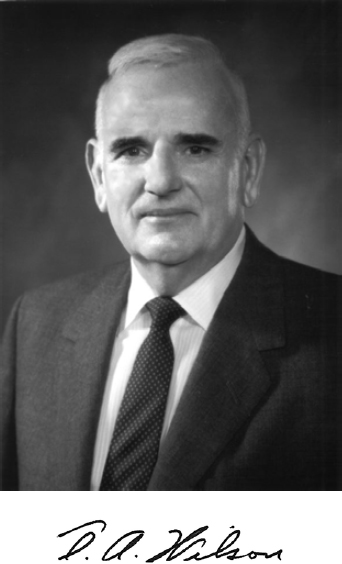This page intentionally left blank.

THORNTON A. WILSON
1921–1999
Elected in 1974
“Leadership in the engineering and management of major complex aerospace systems for commercial and military use.”
BY JOHN D. WARNER AND PHILIP M. CONDIT
THORNTON ARNOLD WILSON, a giant in the aerospace industry, passed away April 10, 1999, at age 78 in Palm Springs, California. Having led the Boeing Company to leadership in the aerospace field, his impact on the technology and business of aerospace around the globe was indeed remarkable.
Born February 8, 1921, in Sikeston, Missouri, T, as he was called, was a farm boy and a true Missourian—the proper name for natives of the “Show-Me” state. He had that Midwestern upbringing with the plain-spoken approach to everything (sometimes he stretched that definition considerably). One never had to guess where he was coming from. He had zero tolerance for nonsense and exaggeration. He appreciated candor and bluntness, as long as they were based on facts and data. He was quoted as saying in an interview that he was “a demanding and tough manager—I was no joy to behold.” This was true only if someone was not performing up to expectations.
He went by T, short for Thornton, not T.A. If someone called his office saying they were a friend of Thornton or T.A., legend had it that his secretary was instructed to hang up, though no doubt she put some polish on that instruction.
He had a commanding presence, and his entry into a room was an electric event. Widely admired, held in awe by many,
feared by some who probably deserved it, T was one of a kind. Yet he was unassuming in his personal life. His favorite restaurant, for example, was a place that most considered rather ordinary; it was inexpensive for sure, which characterized T’s lifestyle.
Wilson graduated from Iowa State University in 1943 with a degree in aeronautical engineering. He joined Boeing that year, leaving briefly for a teaching assignment and advanced study at Iowa State and a year at the California Institute of Technology, where he earned his master’s degree in aeronautical engineering in 1948.
The first Boeing airplane to bear a significant Wilson imprint was the dramatically new B-47 swept-wing bomber. Wilson became project engineer of the B-52 program in 1948 during the latter stages of its design and then led the proposal team that won the Minuteman intercontinental ballistic missile program for the company. He took over active general management of the program and established Boeing as a leader in multicontractor systems integration work of vast size and complexity.
He was elected vice president in 1963 and in 1964 was put in charge of operations and planning for corporate headquarters. Two years later he was named executive vice president. He became company president in April 1968 and was elected chief executive officer in 1969 at the young age of 48. When the company experienced a major downturn in business in the early 1970s, he made the courageous and difficult decisions that kept the company afloat, including slashing 95,000 jobs—two thirds of the payroll. Then he set about growing the company with his bold leadership.
In September 1972 he was elected chair of the board; he continued as CEO until April 1986 and retired at the end of 1987. One of his major impacts on the company was his encouragement to the airplane designers to accommodate future derivatives of new models, which drastically cut development costs while ensuring that new technologies and capabilities could be offered to customers.




